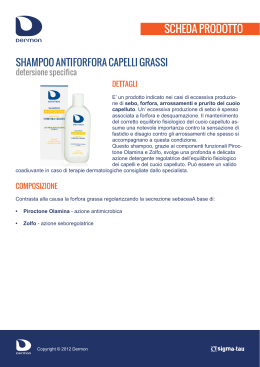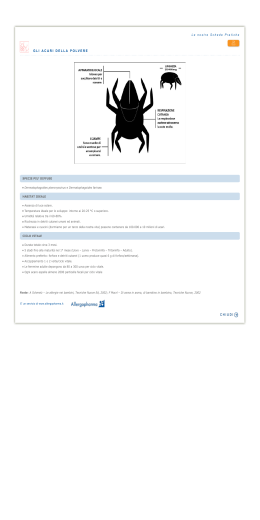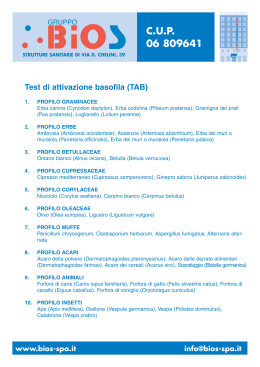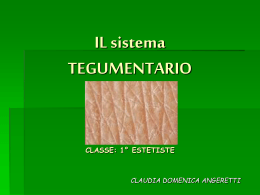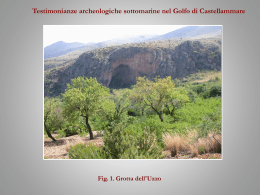J.
Appl. Cosmetol. 4, 153-170 (October/December 1986)
Comparative Experimental Research on Dandruff Through
Quantitative lmage Analysis
K. SCHRADER,
Max - Planck - Strasse 6D - 3450 Holzminden, Germany
Received: October 15, 1986
Key words: Ant idand ruff Preparations, Dandruff Scale Size, Dandruff Ouantity Antindadruff Testing.
In 1982 I a lready reported on the main
and secondary effects of the modern antidandruff preparations. Since then, this
field and partìcularly related experimentation, has always attracted our interest.
We have thus implemented a series of
further works, mainly by means of a system of quantitative instrumental analysis, through which we have carried out
the relevant antidandruff analyses.
First of ali, I would like to say a few
words on dandruff. By this term we conventionally mean a modification of the
horny layer of the scalp, whose cause has
not yet been identified. For this reason,
specialists have not yet agreed if and to
what extent dandruff can be defined as
a disease. It is generai opinion that dandruff is not a pathological deviation and
thus is not a disease.
The scaling of the horny layer is a normai
physiological process. Corneous scales
are norma lly too small to be visible to the
naked eye. On the contrary, in the case of
dandruff, we have the detachment of large agglomerates of corneocytes well visible and aesthetically unpleasant. Furthermore, the quality of the scaling materiai
is decidedly more difficult to determine
(2).
Già nel 1982 relazionai circa l'effetto
principale e secondario di moderni preparati antiforfora (1). Da allora sono stati condotti una serie di ulteriori lavori
sperimentali, u tilizzando soprattutto un
sistema quantitativo di analisi strumentale, con il quale è stato possibile effettuare controlli precisi s u prodotti antiforfora.
Innanzitutto due parole sulla forfora. Per
forfora si intende convenzionalmente una
modifica dello strato corneo del cuoio capelluto, la cui causa non è ancora stata
chiarita. Per questo motivo gli esperti
non sono ancora d'accordo se e fino a che
punto la forfora può essere chiamata malattia.
La desquamazione dello strato corneo è
un normale processo fisiologico. Normalmente le particelle cornee staccate sono
troppo piccole per essere visi bibili ad occhio nudo.
Quando si tratta di forfora invece, si staccano grossi agglomerati di corneociti ben
visibili ed esteticamente fastidiosi. Inoltre, la qualità del materiale di desquamazione è nettamente superiore (2). Esistono diverse opinioni sul trattamento della forfora e come arrivare ad una efficace riduzione della sua quantità. Diversi
154
Comparative Experirnental Research on Dandruff Through
Quantitative Irnage Analysis
Different opinions exist on the treatment
of dandruff and how an effective reduction of its quality can be achieved.
Several authors report on the antimycotic, cytostatic effect (3, 4, 5). Loca! development of parakeratotic affections that subsequantly produce scaling in the
form of dandruff - can be blocked by elimina tìng the increased quantìty of celìs
normally preceding any parakeratosis.
The still questioned theory that changes
in the scalp microflora are the cause of
dandruff was proposed long ago. It has
been proved that the fungus of the yeast
Pityrosporum ovale is found in significantly higher quantities on the scalp
when dandruff is present (6). It was observed that the microbiologica! degradation of human sebum lipids applied on
the shaved back of a guinea pig, induced
the production of dandruff (7); however,
the antimicrobial therapies with tetracycline and neomycin as well as the in loco
destruction of Pityrosporum ovale with
amphotericin B do not reduce dandruff
production (8). Because of thìs result, the
supporters of the microbiologica! thesis
assume that tbe sìgnificant processes take piace in the hair follicles and, thus,
that the normai antibiotics cannot reach
the micro-organisms. Instead, it is known
that pyritions, poorly soluble in water,
but sufficiently in lipids, have an antimicrobial activity as well as effectiveness
against dandruff (9).
The thesis according to which the cytostatic effect can influence dandruff production is excluded because a parallel reduction of sebum production through the
proliferation of lipidic cells should also
occur, but this phenomenon is not observed. It is true that active antidandruff
substances often possess a cytostatic potential, but, according to the author, they
do not penetrate up to the germinative
cells (9).
A further suggestion on the action of ac-
autori parlano di effetto antimicotico o
citostatico (3, 4, 5).
Lo sviluppo locale di focolai paracheratosici - che poi desquamano in forma di
forfora - viene bloccato sopprimendo
l'aumentata quantità di cellule che precede ogni paracheratosi.
Da parecchio tempo esiste la convinzione, tuttora discussa, che il variare della
microflora del cuoio capelluto sia la causa della forfora. Si è potuto provare che
il fungo del lievito pitosporum ovale si
trova in quantità s ignificativamente più
elevata sul cuoio capelluto con forfora
che su quello senza forfora (6). Degradando microbiologicame nte sebolipidi umani applicati sul dorso rasato di cavie, si
è potuto constatare la formazione di forfora (7); tuttavia le terapie antimicrobiche
con tetraciclina e neomicina così come la
distruzione in loco del pitosporum ovale
con amfotericina B non riducono la forfora (8). Chi è convinto della tesi microbiologica, in virtù di ques to risultato suppone che i process i rilevanti si svolgano
nel follicolo pilifero e perciò gli antibiotici usuali non possono raggiungere i microrganismi contrariamente ai piritioni,
poco solubili in acqua, ma abbastanza nei
lipidi, di cui sono noti sia il potenziale antimicrobico che l'efficacia contro la forfora (9).
La tesi che l'effetto citostatico abbia
un'influenza, viene esclusa, poiché si dovrebbe verificare anche una riduzione
nella produzione di sebo mediante la proliferazione delle cellule lipidiche, il che
non avviene. È vero che le sostanze attive antiforfora possiedono spesso un potenziale citostatico, a parere dell'autore
non penetrano però fino alle cellule germinative (9).
Un ulteriore spunto sul principio di azione delle sostanze atti ve antiforfora viene
fornito da Plewig (10). Egli ha esaminato
le proprietà antiinfiammatorie delle sostanze attive antiforfora. L'importanza di
K. Schrader
155
tive antidandruff substances is given by
Plewig (10). He studied the antinflammatory properties of active antidandruff
s ubstances. This important research approach is the result of the findings of
Kligman et al. (2) who could demonstrate that a short and localized infiammatory process provokes parakeratosis that in
turn is responsible for dandruff production. The good antidandruff property of
the highly anti-inflammatory corticosteroids is well known from a long time (11).
According to present knowledge, dandruff can be eliminated without compromising the organism. However, it has also been demonstrated that modem antidandruff preparations are effective du-
questa impostazione risulta dalla scoperta di Kligman e coli. (2) che poterono dimostrare che un processo infiammatorio
breve e locale causa la paracheratosi responsabile della formazione di forfora.
Già da tempo è noto il buon effetto antiforfora dei corticosteroidi altamente antiinfiammatori (11).
Secondo le conoscenze attuali, la forfora
può essere eliminata senza compromettere l'organismo. È però anche dimostrato che l'effetto dei moderni preparati antiforfora ha solta nto la durata del trattamento. Fin'ora non si conosce un metodo per la guarigione definitiva.
La figura 1 mostra lo schema dell'andamento dell'epidermide durante il proces-
Fig. 1: Schematic epidermis figure during the keratinization process (Wella).
Fig. l : Rappresentazione schematica dell'andamento
dell'epidermide nel processo di cheratinizzazione
(Wella).
156
Comparative Experimental Research on Dandruff Through
Quantitative lmage Analysis
ring the treatment only. So far, a method
for the definitive solution of this problem
has not yet been devised.
The Figure 1 shows the scheme of the
trend of the epidermis concerning the keratiniza tion process. This highly significant photographic materia! is drawn
from the pamphlet «Dandruff- A cosmetic problem» (12).
Before reporting on the experiments carried out, we consider useful to provide a
brief description of the main active antidandruff substances (1 (Fig. 2).
Antidandruff cosmetic therapies mainly
so di cheratinizzazione. Questo materiale fotografico molto significativo è stato
preso dall'opuscolo «Forfora - un problema cosmetico» (12).
Prima di parlare degli esperimenti eseguiti, sarà u tile soffermarsi sulle principali sostanze attive antiforfora (1) (Fig. 2).
Nella terapia cosmetica antiforfora si utilizzano soprattut to i derivati piritionici,
come p.e. ottopirox, zincopiritione, così
come magnesio pirit ione e p iritionsolfuro. Con altrettanto buon successo può essere usato il Climbazol (azoileterechetone). L'effetto si sviluppa dopo 2-3 settima-
a:~zn·~:o
ZINCPYR ITHIONE
+
H3 N
c1-1..
'CHi....- , •,1. 'OH
OCTOPIROX
Fig. 2: Antidandruff active agents.
Fig. 2: Le più importanti sostanze attive antiforforali.
K. Sch rader
employ pyrithione derivatives, such as
octopirox, zincpyrithione, as well asmagnes iumpyrith ione and pyritionsulphide.
The u se of Climbazol (azoiletherketone)
gives comparative good results. Its effect
develops after 2-3 weeks of treatment, but
dandruff appears again after 2-3 months
if the treatment is discontinued. The above active substances cannot reduce dandruff induced by pathological causes, for
example, in the case of seborrhoic psoriasis or a llergie dermatitis.
«No activity without a secondary effect».
This statement applies also to andidandruff treatments. As shown in previous
works (1), a more or less relevant production of sebum on the scalp is th e unpleasant secondary effect combined to the use
o f the above highly effective substances.
Research methods so far employed to study antidandruff preparations
In the past, a number of methods have
been developed to contro! the antidandruff effect of products. A p ractical and
easily reproducible method is stili the
half-head test as described by Dietrich
and Boellert (13). In the experimental part
of this work I will d eal again with this relatively easy and fast method.
Other methods are:
- Evaluation of corneocytes (4), both in
relation to their number and (14) to
their sizes. Both methods appear to be
suitable to scientific measurements
but tao complex far rou tine testings.
- Clinica! and visual evaluation prolonged far a certain period of time (4), corresponding to a large extent to the above hair dresser m ethod (13).
- Gravimetrie determination of dandruff (15) after standardized brushing
or aspiration (16). This method was experimented by the author and showed
significant defects.
157
ne dall'inizio dell' uso, ma la forfora riappare dop o 2-3 mesi se il trattamento viene interrotto. Le sostanze attive di cui sopra non possono ridu rre la forfora provocata da cau se patologiche, come per
esempio la psoriasi seborroica e la d erma tite allergica.
Nessuna azione senza effetto secondario .
Questa frase è valida anche per il trattamento antiforfora. Come fastidiosa azione combinata all'uso delle sostanze altamente efficaci di cui sopra, appare sovente una più o meno elevata produzione di
sebo sul cuoio capelluto, come dimostrato in precedenti ricerche (1).
Metodi di ricerca utilizzati finora sui preparati antiforfora
Nel passato è stata elaborata tutta u na serie di procedimenti per il controllo dell'effetto antiforfora d ei prodotti. Un m et odo pratico e ben r iproducibile è tuttora il test eseguito su metà testa, come descritto da Dietrich e Boellert (13).
Di questo metodo relativamente facile e
velocemente eseguibile, se n e parlerà ancora n ella parte sperimentale.
Ulteriori metodi sono:
- Valutazione dei corneociti (4), sia del
loro numero che (14) della loro grand ezza.
Ambedue i m etodi sembrano essere
adatti per misurazioni scientifiche ma
troppo impegnativi per prove di routine.
- Valutazione clinica, del medico, a tempo determinato (4) o valutazione visiva del parrucchiere (13).
- Determinazione gravimetrica della forfora (15) dopo spazzolamento standardizzato oppure dopo aspirazione (16).
Questo metodo è stato eseguito dall'autore e mostra grossi difetti.
- Determinazione dello spessore della
forfora ( 17).
158
Comparative Experimental Research on Dandruff Through
Quantitative Image Analysis
- Determination of thickness of dandruff scales (17).
- Determination of the quantity of dandruff (18) by means of light transmission measurements using the dandruff
photometer.
- Detection of bacteria and fungi present
on the scalp (19).
Further methods are quoted in the bibliography (2, 20, 21, and 22).
- Determinazione della quantità di forfora (18) per mezzo di misurazioni di
trasmissione con il fotometro per forfora.
- Rilevamento dei batteri e dei funghi
sul cuoio capelluto (19).
Ulteriori metodi sono citati nella letteratura (2, 20, 21, e 22).
Esami sperimentali di confronto
Experimental comparative tests
The aim of our work w a s to compare one
known method with a new one. The experimental determinations were carried
out from june 2 to july 15 1986 on 20 volunteers of both sexes, between age 20
and 60, and presenting a dandruff problem. The results were obtained using the
same dandruff so as to compare directly
the methods with one another. The technical evaluation of hair was carried out
on the same subjects.
Lo scopo del nostro lavoro era di confrontare un metodo soggettivo più usuale con
un altro metodo nuovo e più oggettivo.
L'esperimento è stato eseguito dal 2.6 al
15.7.86 su 20 volontari di ambo i sessi affetti da forfora, di età compresa tra 20 e
60 anni. I risultati sono stati determinati
sulla medesima forfora, in modo tale da
poter direttamente confrontare i metodi
tra di loro. La valutazione tecnica della
capigliatura è stata eseguita sulle medesime persone.
L'esame tecnico della capigliatura
Technical testing of hair
Twenty-four people were selected for the
testing and they were requested to undertake in writing that they would not use
hair cosmetics and wash their hair for the
entire period of treatment.
In order to evaluate the initial status of
dandruff, the hair was twice a week for
two weeks with 2-5 ml (depending on hair
length) of a placebo shampoo whose composition was the following:
50% Na-laurilethersulphide (28%)
50% demineralized water, sodium chloride as viscosizer, perfume and preservative.
Quantity and temperature of the water
used for rinsing ha ve been standardized.
Before starting the treatment, the status
of dandruff was determined on half-head
Prima di tutto sono state scelte 24 persone che hanno dovuto impegnarsi per
iscritto a non utilizzare cosmetici per capelli e a non lavarsi i capelli per tutto il
periodo della prova.
Per l'accertamento dello stato iniziale
della forfora abbiamo lavato i capelli due
volte la settimana per 2 settimane con 2-5
ml (a seconda della lunghezza dei capelli) di shampoo placebo, per due volte.
La composizione dello shampoo era la seguente:
50% Na-laurileteresolfato (al 28%)
50% acqua demineralizzata, cloruro di
sodio come viscosizzante, composizione
profumata e conservante.
La quantità di acqua per il risciaquo e la
temperatura sono state standardizzate.
Prima dell'inizio del trattamento su me-
K. Schrader
159
by two expert hairdressers; four people tà testa è stato determinato lo stato delwere eliminated for not presenting the la forfora da due parrucchiere specializsuitable type of dandruff. We have, thus, zate; 4 persone sono state scartate per il
chosen 20 volunteers with different types tipo di forfora non idonea. Abbiamo dunof well visible and evenly spread dan- que scelto 20 volontari con forfora diverdruff.
sa, ben visibile e ben distribuita.
We determined in twenty the minimum Si è stabilito in 20 il numero minimo di
number of subjects necessary to compa- soggetti indispensabili per ottenere un rire the methods with statistica! relevance. sultato statisticamente valido, anche se
In arder to obtain better results, testings è preferibile operare con 30 e più persocarried out on 30 or more subjects are ne.
certainly more significant.
I capelli dei volontari sono stati trattati
The volunteers' hair was treated as fol- durante 4 settimane, due volte la settimalows: 2-5 ml of test product were applied na, su metà testa per due volte, con 2-5
during 4 weeks twice a week, on half- ml del preparato in sperimentazione. I
head. The products contained the active preparati contenevano la sostanza attiva
substance, octopirox, in a 0.3/0.8% con- Octopirox nella concentrazione di
centration. After four weeks of treatment 0,3-0,8%. Dopo 4 settimane di trattamenthe testing was discountinued.
to la sperimentazione è stata interrotta.
As known, treatment tests are normally È noto che dopo tests di trattamento è nefollowed by an observation period of cessario un periodo di osservazione di
about three weeks. During this time, hair circa 3 settimane. Durante questo periowashings are done using the product wi- do si eseguono dei lavaggi di tutta la tethout the active substance and the status sta con il prodotto senza sostanza attiva
of dandruff is then examined. Since the e quindi si esamina lo stato della forfoobjective of our research was a different ra. Poiché il motivo della nostra ricerca
one, we did not complete this phase of the era un altro, abbiamo tralasciato questa
testing.
fase.
The evaluation was made directly on La valutazione è stata determinata direthead by two hairdressers, separately and tamente sulla testa da due parrucchiere,
weekly, after shampooing; the following separatamente e settimanalmente dopo la
score was given:
messa in piega, con il seguente punteggio:
O =absent dandruff
0.2 = sporadic dandruff
l =moderate dandruff
2 =high quantity of dandruff
3 =very high quantity of dandruff
O =senza forfora
0,2 =forfora sporadica
1 =forfora moderata
2 =forfora forte
3 =forfora molto forte
For the evaluation, average values were
calculated, and for the assessment of statistica! differences among products, the
Dixon and Mood test was used (23). We
also standardized dandruff by removing
scales from heads with a special comb
and transferring them on a plate (12) (Fig.
3). We have then washed and dried halfhead hair.
Per la valorizzazione sono stati calcolati
i valori medi e per l'accertamento delle
differenze statistiche tra i prodotti è stato utilizzato il test di Dixon e Mood (23).
Nello stesso tempo si è cercato di standardizzare la forfora, togliendola dalle teste con un pettine speciale e trasferendola su dei portaoggetti (12), dove è stata
successivamente fissata con un secondo
160
Comparative Experimental Research on Dandruff Through
Quantitative Image Analysis
Flg. 3: Hair dandruff, a) on the scale, b) on plates.
Fig. 3: Forfora del cuoio capelluto a) s ulla testa - b)
sul portaoggetti.
161
K. Schrader
Evaluation
Using the method of image analysis (Fig.
4), we have carried out the evaluation, as
follows: a diascopic microscopy image of
the dandruff to be measured is put into
the image computer of the apparatus by
means of a camera. Using different logarithms of image analysis, hair, particles
of dust and other objects invisible to the
naked eye are eliminated, while dandruff
scales are identified; they appear as more or less dark objects (Fig. 5).
portaoggetti (fig. 3). Infine, una metà testa è stata lavata e asciugata.
Valorizzazione
Eliminated the dandruff scales touching
La valorizzazione è stata effettuata con il
metodo dell'analisi d'immagine (fig. 4) nel
modo seguente: un'immagine della forfora al microscopio diascopico da misurare viene introdotta con una macch ina fotografica nel calcolatore d'immagine dell'apparecchio apposito. Con diversi logaritmi di analisi d'immagine si eliminano
capelli, particelle di polvere e oggetti invisibili ad occhio nudo e -si identificano
le particelle di forfora che appaiono co-
Fig. 4: Image analysis apparatus IBAS.
Fig. 4: Apparecchio per l'analisi d'immagine IBAS.
Determination of dandruff scale size
Comparative Experimental Research on Dandruff Through
Quantitative Image Analysis
162
the edge of the image, each dandruff scale area appearing in the view-field is measured in mm 1 (Fig. 6 and 7). The medium
value of scale is calculated for each of the
2 X 20 view-fields, and for each sample
(the average value is Jess suitable as the
sizes of dandruff scales are distributed
logarithmically).
By Wilcoxon test (24), it was determined,
through the 2 X 20 medium values per replica, the significant differences in sizes
between the two shampoos tested on half
scalp at different times.
me oggetti particolarmente grandi e più
o meno scuri (fig. 5).
Determinazione della grandezza delle
particelle di forfora
Di ogni particella completa di forfora che
si trova nel quadro si misura la superficie in mm 1 . Prima si eliminano tutte le
particelle che toccano il bordo dell'immagine e che risultano, perciò, incomplete
(fig. 6 e 7).
Per ognuno dei 2 X 20 quadri, per ogni
prelievo, si calcola un valore mediano di
particelle (il valore medio è meno adatto, perché le grandezze delle particelle di
forfora sono distribuì te logaritmicamente).
Con il test di Wilcoxon (24) sono state verificate, mediante i 2 X 20 valori media-
Determination of dandruff quantity
Before eliminating the scales touching
the edge of the image, and before m easuring the size of dandruff scales, the percentage of image surface covered with
,.,.
•. .
..,.
.....
.
•
...
~
•
•
....
....,.
.
.. ... ..
• •
•
•
.. .. ·:
Fig. 5: Hair, dust and dandruff.
•
...
••
(•
\
•
• "
•
.
•
•
.
..
,
•
·,
....
..
.
•
....
•
'·
•
.
...•
..
•
Fig. 5: Capelli, polvere e forfora .
K. Schrader
163
.. ,........ ...
.. ..
•'•
\,
...
•
l ••
••
.•
..
>.
.,
.. ' . ..
.., . •.
•
•
...
:l .
~
,
.
.·•
"
Fig. 6: Dandruff scales touching the edge of the
Fig. 6: Particelle di forfora che toccano il bordo del-
image.
l'immagine.
Fig. 7: Dandruff area measured by IBAS.
Fig. 7: Superfici delle squame forforali calcolate
dall'IBAS.
164
Comparative Experimental Research on Dandruff Through
Quantitative Image Analysis
dandruff, i.e. the quantity of dandruff, is
to be measured.
By this method, it is possible to test exactly the same scales used far size determination, appling exactly the same image
analys is procedure.
For each plate, images are carried out in
10 dìffe rent points, so as to allow comparison of 2 X 200 measurement values far
a statistica! evaluation. Also in this case,
significant differences between the two
products used on half h ead are identified
through the Kolnogoroff-Smirnow method (25) and then through the median
test with four-field plates (26).
Results
By comparing the subjective measure-
ni per coppia, le eventuali differenze significative di grandezza tra i due shampoos testati s u metà testa , a periodi diversi.
Determinazione della quantità di forfora
Prima di eliminare le particelle che toccano il bordo dell'immagine, e prima di
misurare, quindi, la grandezza delle particelle di forfora, s i calcola la percentuale della superficie dell'immagine coperta da forfora, e, infine, la quantità stessa
di forfora.
Con questo procedimento vengono valutate le stesse particelle che sono state utilizzate per la determinazione della superficie utilizzando sempre il medesimo pro-
(n = 20)
0,8 % OCTOPIROX
~
OCTOPIROX
~
w 2
a:
o
CJ
cn
o
2
3
WEEKS
Flg. 8: Decrease in dandruff quantity subjective method.
4
5
6
~
Fig. 8: Grafico della riduzione q uantitativa soggettiva della forfora.
165
K. Schrader
ment of dandruff reduction with the measurement carried out on the same subjects through the quantitative image analysis, a good accordance is found (Figs. 8
and 9). However, as far as the reduction
in size of dandruff scales is concerned,
the diagram shows only a trend towards
reduction of dandruff quantity. It is not
possible to see a difference between the
two concentrations. On the other hand,
the remaining two figures show a clear
difference in effectiveness of the two concentrateci solutions. One can thus assume
that a shampoo containing a 3.3% octopirox concentration is sufficient to eliminate dandruff for a good period, i.e. at
least for the time of treatment.
By comparing the two methods, one can
observe that the sìmple determination by
the half-head testing corresponds to the
more complex, scientific test based on the
irnage analysis method for measuring the
reduction of the quantity of dandruff. Moreover this method ensures, obviously for
the 20 subjects considered, more significant results than the size reduction of
dandruff scales detected with the quantitative image analysis.
Assessment of methods through the halfhead testing of an antidandruff preparation and of a placebo shampoo
Since the method of size determination
of dandruff scales revealed to be surprisingly ineffective, we wanted to ascertain
for which reason this method, frequently
and successfully employed, has not given
the expected results, in spite of the further precision of rneasuring applied, and
of the considerable efforts made.
Another relevant difference of the testings was due to the fact the two shampoos, containing active substances were
tested by comparison and this did not allow to assess the change in sizes of clan-
cedimento dell'analisi d'immagine, eliminando quelle particelle posiziona te sul
bordo dello schermo.
Per ogni portaoggetto si verificano le immagini su 1O punti differenti, cosicché
vengono valutati statisticamente 2 X 200
valori di misurazione. Le differenze significati ve dei due prodotti sono state valutate sempre su metà testa, utilizzando il
metodo di Kolmogoroff-Smirnow {25) e
conseguentemente il test mediano con lastre a 4 campi (26).
Risultati
Confrontando la riduzione della forfora
evidenziata soggettivamente con quella
misurata sulle medesime persone con l'analisi dell'immagine quantitativa, si può
constatare una buona concordanza (fig.
8 e 9) specie se si considera quale confronto tra un metodo scientifico oggettivo ed
uno soggettivo.
In relazione alla riduzione della grandezza delle particelle di forfora, il grafico
mostra soltanto una tendenza alla diminuzione della quantità di forfora . Non è
possibile notare, infatti, attraverso i grafici una differenza tra le due concentrazioni. La differenza di efficacia tra le due
soluzioni concentrate viene, invece, rilevata nettamente. Si può, quindi, desumere che uno shampoo al 3,3% di octopirox
sia già sufficiente per sconfiggere la f orfora per un certo periodo di tempo, ossia
almeno per un prolungato periodo di trattamento.
Paragonando i 2 metodi si nota che la determinazione semplice con il test di metà testa è sovrapponibile a quella più impegnativa e scientifica del metodo dell'analisi dell'immagine, per quanto attiene
la riduzione della quantità di forfora.
Quest'ultimo metodo, però, fornisce ovviamente, su 20 persone, risultati più si-
Comparative Experimental Research on Dandruff Through
Qua ntitative Image Analysis
166
(n = 20)
-
5
~
§
0,8 % OCTOPIROX
0,3 % OCTOPIROX
'$.
- 4
>t-
j:::
Z3
<(
:::::>
~2
LL
:::::>
a:
e
z
<(
e
o
1
2
3
4
WEEKS
__,._
Fig. 9: Decrease in dandruff quantity: image analysis method.
5
6
Fig. 9: Riduzione quantitativa della fo rfora med iante
il m etodo dell'analisi dell'immagine.
(n = 20)
0,4 % OCTOPIROX
PLACEBO
3+------------ -- -- -- - - - -w
~
2+----;---;
(.)
cn
o
2
3
WEEKS
Fig. 10: Decrease in dandruff quantity: subjective
rnethod.
4
5
6
~
Fig. 10: Grafico della riduzione quantitativa soggettiva della forfora.
K. Schrader
druff scales induced by external factors,
using a placebo shampoo. As compared
to a placebo, a test shampoo, with an average content of octopirox, should at least
provide a significant reduction in dandruff scale sizes.
As contro!, we carried out on other 20
people the above testings. The placebo
shampoo was left on half-head after the
initial phase. Furthermore, the upper
part was dyed so as to provide the impression of a new product to the subjective observer. The shampoo containing an
active substance consisted of a preparation containing 0.4% octopirox.
Results
Again, a good accordance is observed between the subjective and objective reduction of dandruff quantity. The placebo induces a slight decrease in dandruff quantity, probably due to frequent in-depth
hair washings during the testing. After
the second week of treatment, the difference between placebo and active product becomes significant (Figs. 10 and 11).
As for size reduction of dandruff scales,
the very high value oscillation of placebo appears evident during the measuring
period. After a dramatic decrease up to
the second week of treatment, a definite
increase is observed.
Nevertheless, after 3/4 week application
of the active shampoo, dandruff scales
are much smaller than after application
of the placebo shampoo (Fig. 12).
Evaluation of results
The determination of size reduction of
dandruff scales is a suitable method to
assess the effectiveness of products having a different content of active substance. However, it is too imprecise to allow
167
gnificativi sulla riduzione della grandezza delle particelle di forfora.
Verifica dei metodi con il test di metà testa di un preparato antiforfora e uno
shampoo placebo
Dato il risultato insufficiente e non previsto ottenuto sulla determinazione di
grandezza delle particelle di forfora, si è
voluto accertare per quale motivo questo
metodo, utilizzato spesso e con successo,
non abbia dato i risultati dovuti, m algrado la precisione con cui è stata effettuata la misurazione.
Si è voluta così eliminare l'eventualità
che la riduzione della grandezza delle
particelle fosse legata ad influenze esterne, quali i prodotti attivi utilizzati tra di
loro per confronto, a diverse concentrazioni. In confronto al placebo, uno shampoo con un contenuto medio di octopirox
avrebbe potuto fornire una riduzione più
significativa della grandezza delle particelle di forfora.
Per un controllo è stata condotta, quindi, una ulteriore prova sperimentale come descritta prima con altre 20 persone.
Lo shampoo placebo è stato lasciato agire su metà testa ed è stato colorato, per
dare all'osservatore l'impressione di utilizzare un nuovo prodotto. Lo shampoo
con sostanza attiva era costituito di un
preparato con lo 0,4% di octopirox.
Risultati
I risultati ottenuti sulla riduzione della
quantità di forfora rilevabile soggettivamente e oggettivamente risultano di nuovo sovrapponibili. Il placebo causa una
leggera diminuzione della quantità di forfora, provocata, probabilmente dalla frequenza del lavaggio a fondo praticato sui
capelli durante il test. Dopo la seconda
168
Comparative Experimental Research on Dandruff Through
Quantitative lmage Analysis
(n = 20)
--45
~
~
OCTOPIROX
;f?.
>
....
j:::
z 3
<
::>
o
LL
LL
2
::>
a:
e
z
<
e
o
4
3
2
.......
WEEKS
Fig. 11 : Decrease in dand ruff quantily.
5
6
Flg. li: Grafico della r iduzione quantitativa della
forfora.
(n = 20)
o
o
,...
8...-------- - - --
- - - - - -- iw,i
---,
0,4% OCTOPIROX
~
7+-~~~~~~~~~~~~~~~~~~~~~~~~~~
;;PLACEBO
§
~ 6+-~~~~~~~~~~~~~~~~~~~~
;; 5-f--~~~--f,7,~~~~~~~~~~~~~~,,.,.-i
N
cn 4 +----f=:::::=iE
tt 3 +-----4===1f
::>
~
z
2 +----;::==11
<
e
o
1
2
4
3
WEEKS
Fig. 12: Determination of dandruff size: image analysis me tho d.
5
6
....,..
Fig. 12: Grafico della riduzione della grandezza della
forfora.
K. Schrader
a differentiation of products with different content of active substance, which,
on the contrary, can be obtained by
means of the measuring with the image
analysis method.
If we want to compare different preparations without much effort and costs, we
can use the subjective determination of
dandruff quantity that gives good results,
provided qualified staff is available.
The advantage of the image analysis method far measuring dandruff quantity
consists in the possibility of obtaining objective results of quantitative measuring,
that are not influenced by subjective interpretation.
169
settimana di trattamento, la differenza
tra placebo e prodotto attivo diventa significativa (fig. 10 e 11).
Circa la riduzione della grandezza delle
particelle di forfora, risulta soprattutto
evidente l'enorme oscillazione dei valori
ottenuti con il placebo, durante il periodo di misurazione, infatti, dopo una vistosa diminuzione rilevabile fino alla seconda settimana di trattamento se ne nota,
successivamente un chiaro aumen to.
Nonostante ciò, dopo 3-4 settimane d i utilizzo dello shampoo attivo, le particelle
di forfora sono mo! to pù piccole che dopo l'uso del placebo (fig. 12).
Valutazione dei risultati
L'accertamento della riduzione di grandezza delle particelle di forfora è adatto
per la verifica dell'efficacia di prodotti
antiforfora, ma è troppo impreciso per
differenziare prodotti con diverso contenuto di sostanza attiva, contrariamente
alla misurazione con il metodo d ell'analisi dell'immagine.
L'accertamento soggettivo della quantità
di forfora fornisce buoni risultati, se si
ha a disposizione personale qualificato e
se si vogliono paragonare diversi preparati senza troppo impegno e spese.
Con il metodo d'analisi dell'immagine per
la misurazione della quantità di forfora
si ottengono però risultati oggettivi di misurazione quantitativa, non dipendenti da
influenze soggettive.
170
Comparative Experimental Research on Dandruff Through
Quantitative Image Analysis
REFERENCES
1. K. Schrader (1982), SOFW, 108 Jg.. Nr. 15, 471.
2. C.E. Orfanos (1979) ccHaar und Haarkrankheiten», G. Fischer Verlag Stuttgart, New York 663-680.
3. A.M. Kligman, K.J. Mc Glnley, J .J . Leyden (1976), ccThe Nature of dandruff», J. Soc. Cosmet. Chem.,
27, 111.
4. A.M. Kligman, R .R. Marples, L.R. Lantls, K.W. Mc Ginley (1974), «Appraisal of efficacy of antidand r uff formulations », J. Soc. Cosm. Chem., 25, 73-91.
5. G. Plewlg, A.M. Kligman (1969) , «The Effects of Selenium Sulfide on epi<lermal turnover of normai
and dand ruff sca lps>>, J. Soc. Cosm. Chem., 20, 767.
6 . K.J. Mc Ginley, J .J . Leyden, R .R. Marples, M.R.C. Path and A.M. Kligman (1975), «Quantitative microbiology of the scalp in non-dandru ff, dandruff, and seborrheic <lermatit is», J. lnvest. Derm. 64, 401.
7_ J.A. Troller (1971), • Model s istem for the investigation of dandruff», J. Soc. Cosmet. Chem., 22, 187.
8. J .J . Leyden, K .J. Mc Glnley, A.M. Kligman (1976), «The Role of micro-organisms in dandruff•, Arclz.
dermatol., 112, 333.
9. N.J. van Abbé, D. Head, J.V. Reed, E.A. Murrelland, P.M. Baxter (1986), «Dandruff: infection or not?»,
I. Cosmet. Sci. 8, 37-44.
10. G. Plewlg, Schopf (1975), «Anti-inflammatory effects of antimicrobial agents: an in vivo study», I. lnvest. Dermatol. 65, 532.
11. H.J. Spoor, A.M. (1966), Perfume Cosmet. 81 (JO), (81).
12. «Kopfschuppen - eln kosmetlsches Problem», Herausgeber: Wella AG, Darmstadt/R. Rèithlisberger.
13. G. Dletrich und V. Bolieri (1980), Arzt/. Kosmetologie IO, 34-45 .
14. E. Holzle, J. Park, G. Plewlg (1980), Akt. Derm., 6, 75-81.
15. P. Finkelsteln, K. Laden (1968), «An obj ective m etho<l for evalu ation of dandruff severity», J. Soc. Cosm.
Chem., 19, 668-673.
16. R.W. Vanderwyk, K.E. Hechemy (1967), «A comparison of the bacterial and yeast of the human scalp
an<l their effect upon dandruff production », J. Soc. Cosm. Chem., 18, 629-639.
17. H. Eberhard, G. Trick (1979) Arztl. Kosm., 9, 11-14.
18. F. Schiller, K. Langguth, M. Grauel, J . Anton (1984), Kosmetiksymposium Karl-Marx-Stadt, S. 89-91.
19. R .W. Vanderwyk, F .C. Roia jr. (1964), «The reationship between dandruff and m icrobia l flora of the
human scalp », J. Soc. Cosmet. Chem. 15, 761.
20. M. Gloor (1982), «Pharmakologie dermatologischer Exteman, Sprin ger Verlag, Be rlin, Hcidelberg, New
York.
21. H. Tronnier (1975) • Parflim e r!~ und Kosmetik» 56, 31-39.
22. P. Liipke, P. Preussen (1978), Arztl. Kosm. 8, 269-280.
23. Ibid. 247-248.
24. Lothar Sachs (1984), Angew. Statistik, 6. Aufl., Springer Verlag Berlin, Heidelbe rg, New York, Tokyo,
244-246.
25. Ibid. 228-230.
26. I bid. 236-238.
Scarica
